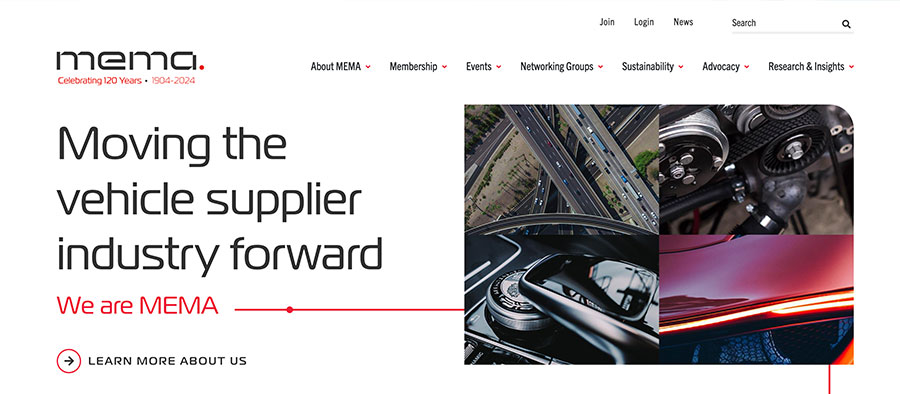
Industry Disruption: How Consolidating 5 Websites into 1 Positioned MEMA for the Future

MEMA, The Vehicle Suppliers Association, represents the largest manufacturing sector in the United States — the vehicle supplier industry — with more than 4.8 million jobs. The motor industry continues to experience disruptions, and for MEMA, this affects their vehicle supplier corporate members across market segments: aftermarket, commercial vehicle, original equipment, remanufacturing, and sustainability.

With so much disruption and fragmentation within the market, MEMA realized they needed to realign and reposition for the future, focusing on converging its four divisions under one umbrella organization with two distinct membership groups: MEMA Aftermarket Suppliers and MEMA Original Equipment Suppliers. President and CEO Bill Long says, “We see supplier needs and priorities shifting as well as overlapping across industry and sector. That’s why we executed the realignment, and the new brand to better advance the business interests of vehicle suppliers”.
The strategic brand consolidation presented opportunities from an online perspective, as their new website needed to showcase a single, unified brand, including new positioning, messaging, content and functionality. This required us to consolidate five different motor vehicle supplier sites into one overarching brand experience. We created the new mema.org on the Drupal platform, which served as the home for all member organizations including personalized content (i.e. events, resources) and new features being rolled out incrementally.
Our collaboration with MEMA took on the common approach of “building the plane while we’re flying it,” meaning the website project was running in parallel with the rebrand. All teams had to get creative to work concurrently where possible and take a strict approach to agile development and implementation to meet MEMA’s launch goals.
Strategically our work centered on the following themes:
Implementation Strategy #1 - Creating a Unified Website for Multiple User Groups
The Challenge
MEMA was integrating five different associations into one online brand experience, which prompted concern about members feeling that they have a home. How would they know they were in the right place? The previous five sites were similar, but each had its unique brand, look and feel and features that their respective users had grown accustomed to. The new brand launch required mema.org to serve as the home for all of these different association members at the same time.
The Solution
To support a wide variety of content requirements, Drupal page templates needed to be designed and implemented in an extremely flexible way. For example, an article page type didn’t have the same requirements across the previous five sites so flexibility was needed to properly house all formats while also supporting a much more modern, clean design.
Through the use of Layout Builder, we were able to provide the level of flexibility needed to support MEMA’s brand, digital and content transformation. We used Layout Builder to satisfy the content admins' requirements, knowing that there was a major shift in content (most prominent pages needed to be completely overhauled) and the UI creative design (new visual identity and brand standards). Content admins needed to have a high degree of flexibility to support the unknowns.
Additionally, a unifying taxonomy needed to be created as certain page formats had differently named terms across the previous five sites. Some term redundancy needed to be eliminated to have a clean list of page types while also creating a “Market Segment” content type allowing content editors to classify content not only by format and topic but also by segment. This allowed users to filter lists by one of the previous five sites.
Implementation Strategy #2 - Iterative Approach to Personalization
The Challenge
Content editors now have the flexibility to add content for any of the previous sites, and all user groups have relevant content throughout the homepage and the rest of the site.
The prior model supported five sites and organizations, so each site had some level of inherent personalization, as the content was specifically geared to that association’s audience.
Now, with a single brand and single-site model, there is a great deal of content and callouts on the homepage that aren’t necessarily relevant to every user. Content, news, events, and research can vary greatly based on whether a member is an aftermarket or original equipment supplier or they work in different market segments.
The Solution
To create a personalized experience for users, we developed unique callouts and alerts as part of the initial rollout. Post-launch, we conducted usability studies with MEMA members to understand their needs, additional requirements, insights and opportunities where we could improve the experience. This also allowed us to prioritize personalization needs (that users really care about) and new features and enhancements (development backlog).
Through the UX research, we identified opportunities for personalization and prioritized those opportunities based on both an improved user experience and an important business case. Starting with invoice alerts based on a user’s data via a Salesforce integration and then personalized homepage CTAs based on a user’s membership type, personalization is being rolled out iteratively. User feedback and shifting business goals help inform the next batch of personalization enhancements, so the highest value updates continue to be delivered.
Implementation Strategy #3 - Identifying the MVP to hit a new launch date
The Challenge
Not long after the project kickoff, MEMA’s launch date moved up by a few months so that the website launch could align with the launch of the new brand. This meant that we needed to reassess the entire timeline and scope of the MVP to meet the new deadline.
The Solution
By working collaboratively with the MEMA team, we were able to redevelop the project scope and timeline to hit the new launch date. We identified the post-launch priorities and refocused the scope for pre and post-launch phases. To ensure we still captured the voice of the customer, we moved some of the user research tasks, designs, and development work into a new post-launch project.
Adapting was necessary while also providing opportunities to redefine success. Instead of conducting usability testing on wireframes, we were able to get user feedback on the live website. Deprioritized features (e.g. more advanced search, additional UI patterns and system integrations) were able to be reevaluated post-launch against new user requests and new business requirements.
Remaining flexible and agile within the project allowed our integrated teams to meet an aggressive launch date while still delivering on the most important items, making the launch a success.
Does this project feel familiar? We’d love to discuss how to support your needs. Let’s schedule a call!




